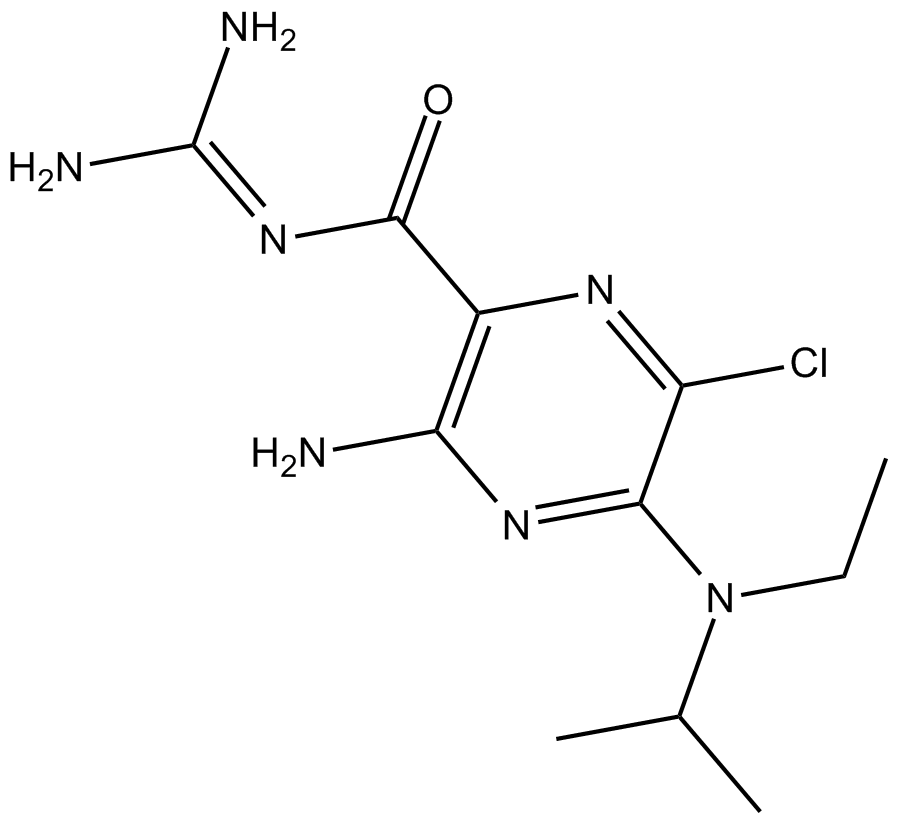EIPA (Synonyms: L-593,754, MH 12-43, 5-(N-ethyl-N-isopropyl)-Amiloride) |
| Catalog No.GC15893 |
EIPA inhibited TRPP3-mediated Ca2+-activated currents with IC50 values of 10.5 µM.
Products are for research use only. Not for human use. We do not sell to patients.

Cas No.: 1154-25-2
Sample solution is provided at 25 µL, 10mM.
EIPA inhibited TRPP3-mediated Ca2+-activated currents with IC50 values of 10.5 µM [1]. TRPP3, a member of the transient receptor potential (TRP) superfamily of cation channels, is a Ca2+-activated channel permeable to Ca2+, Na+, and K+ [1].EIPA (5-(N-ethyl-N-isopropyl)-amiloride) is a commonly used amiloride derivative modified similarly to MPA, and its Ki for NHE1, NHE2, and NHE3 are 0.3, 1.8, and 67 µM, respectively[2,3]
EIPA suppressed proliferation of MKN28 cells through up-regulation of p21 expression via reduction of [Cl- ] c as a result from DIDS-sensitive Cl- /HCO3- exchanger-mediated compensation for keeping pHc normal under an NHE-inhibited condition [4].
EIPA preischemic treatment overcame the I/R-induced renal dysfunction. Histologic examination of the kidney of vehicle-treated ARF mice revealed severe lesions, and these lesions were significantly suppressed by the preischemic treatment with EIPA. In addition, EIPA suppressed the increment of renal ET-1 content after reperfusion [5]. EIPA at doses of 3 and 9 mg/kg per day inhibited tumor growth of HepG2 modle mice significantly compared with the control [6].
References:
[1]. Dai XQ, Ramji A, Liu Y, Li Q, Karpinski E, Chen XZ (2007) Inhibition of TRPP3 channel by amiloride and analogs. Mol Pharmacol 72:1576-1585
[2]. Guffey, S.C.; Fliegel, L.; Goss, G.G. Cloning and characterization Na+/H+ Exchanger isoforms, NHE2 and, NHE3 from the gill Pacific dogfish, Squalus suckleyi. Comp. Biochem. Physiol. Part B Biochem. Mol. Biol. 2015, 188, 46-53.
[3]. Masereel, B. An overview inhibitors Na+/H+ exchanger. Eur. J. Med. Chem. 2003, 38, 547-554.
[4]. Hosogi SMH, Nakajima K, Ashihara E, Niisato N, Kusuzaki K, Marunaka Y: An inhibitor of Na(+)/H(+) exchanger (NHE), ethyl-isopropyl amiloride (EIPA), diminishes proliferation of MKN28 human gastric cancer cells by decreasing the cytosolic Cl(-) concentration via DIDS-sensitive pathways. Cell Physiol Biochem. 2012, 30: 1241-1253. 10.1159/000343315.
[5]. Yamashita J, Ohkita M, Takaoka M, Kaneshiro Y, Matsuo T,Kaneko K, Matsumura Y.Role of Na+/H+ exchanger in the pathogen-esis of ischemic acute renal failure in mice.J Cardiovasc Pharmacol49:154 -160, 2007.
[6]. X. Yang, D. Wang, W. Dong, Z. Song, K. Dou.Expression and modulation of Na+/H+ exchanger 1 gene in hepatocellular carcinoma: a potential therapeutic target. J. Gastroenterol. Hepatol., 26 (2) (2011), pp. 364-370
Average Rating: 5 (Based on Reviews and 13 reference(s) in Google Scholar.)
GLPBIO products are for RESEARCH USE ONLY. Please make sure your review or question is research based.
Required fields are marked with *




